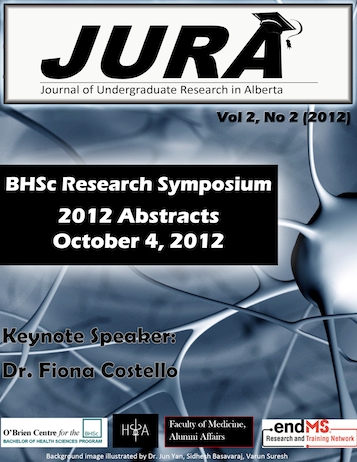Defining The Role of Primary Cilia on Skin Derived Precursors.
Keywords:
Skin Derived Precursors, Primary Cilia, Hair Regeneration, Wound HealingAbstract
Isolated in 2001, Skin Derived Precursors (SKPs) represent a novel population of multipotent stem cells1,2 residing at the base of hair follicle where they play a key role in defining the physiology and regeneration capacity of hair follicles and skin (Biernaskie et al. 2009). In order to understand how SKPs behavior is regulated in the skin, we asked whether primary cilia, microtubule bundles projected from the cell surface that transmit chemical signals between cells4, are present in the dermal papilla and dermal sheath in-vivo and in the population of isolated SKPs. In our investigation, we performed immunohistochemistry for acetylated tubulin and showed that SKPs do have cilia. We then tested whether these cilia can be elongated following treatments of lithium chloride on these dermal precursors. We then asked whether elongation of cilia has an effect on the self-renewal capacity of SKPs and whether drugs elongating cilia can work synergistically with Platelet Derived Growth Factor (PDGF), a growth factor that we have previously shown to improve cell growth and cell division.
Experiments assessing the self-renewal capacity of SKPs suggested significant increase in the diameter and the number of spherical presence when treated with lithium chloride and when lithium chloride is added in combination with PDGFβ when compared to PDGFβ alone. This suggests that signaling in cilia may influence PDGF signals causing an enhanced effect on SKP proliferation. Further experiments including knocking down primary cilia by blocking the transcription of ciliary protein using shRNA and in-vivo transplantations of lithium chloride and PDGF treated SKPs in a hair follicle formation assays will be executed to understand the key roles of primary cilia on SKPs. These studies will ultimately aim to answer whether drugs affecting cilia can function as potential therapeutic targets for autologous adult stem cell based therapies.
Downloads
References
2) Fernandes KJ, Toma JG, Miller FD. Multipotent skin-derived precursors: adult neural crest-related precursors with therapeutic potential. Philos Trans R Soc Lond B Biol Sci. 2008 Jan 12;363(1489):185-98. Review.
3) Biernaskie J, Paris M, Morozova O, Fagan BM, Marra M, Pevny L, Miller FD. SKPs derive from hair follicle precursors and exhibit properties of adult dermal stem cells. Cell Stem Cell. 2009 Dec 4;5(6): 610-23.
4) Goetz SC, Anderson KV (2010) The primary cilium: a signalling centre during vertebrate development. Nat Rev Genet 11(5):331–344.
Downloads
Published
Issue
Section
License
Authors retain all rights to their research work. Articles may be submitted to and accepted in other journals subsequent to publishing in JURA. Our only condition is that articles cannot be used in another undergraduate journal. Authors must be aware, however, that professional journals may refuse articles submitted or accepted elsewhere—JURA included.


